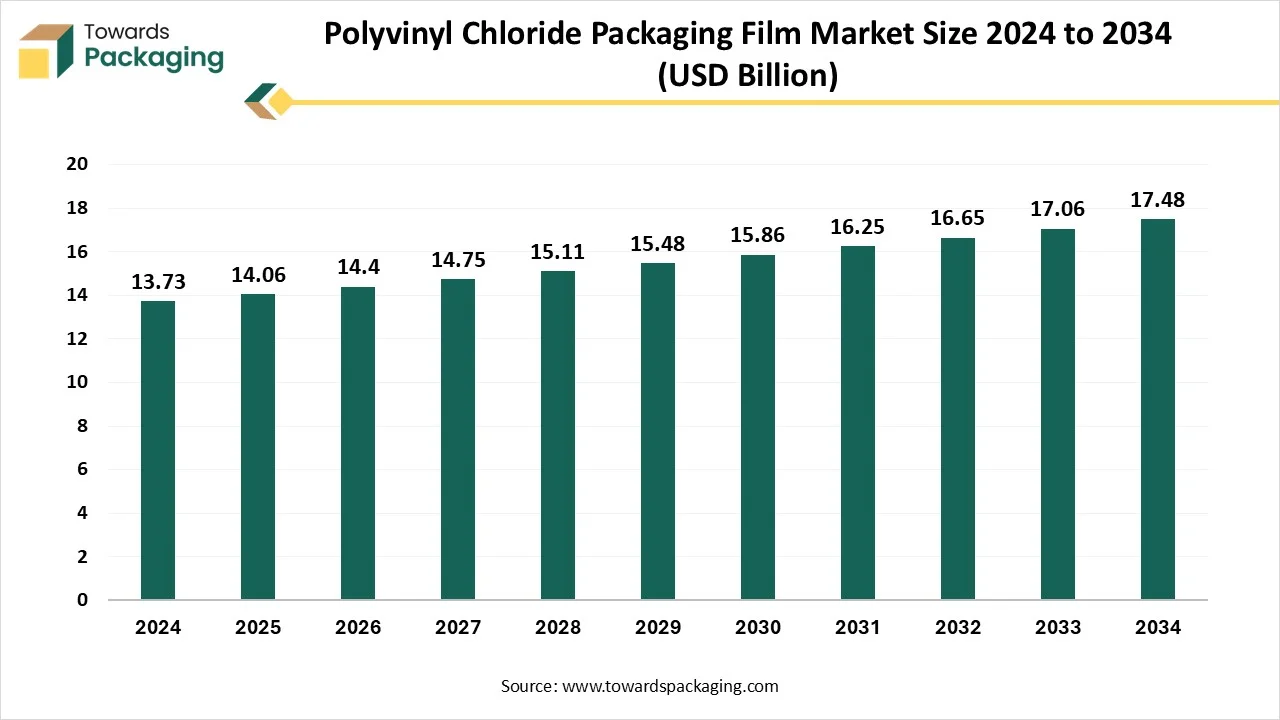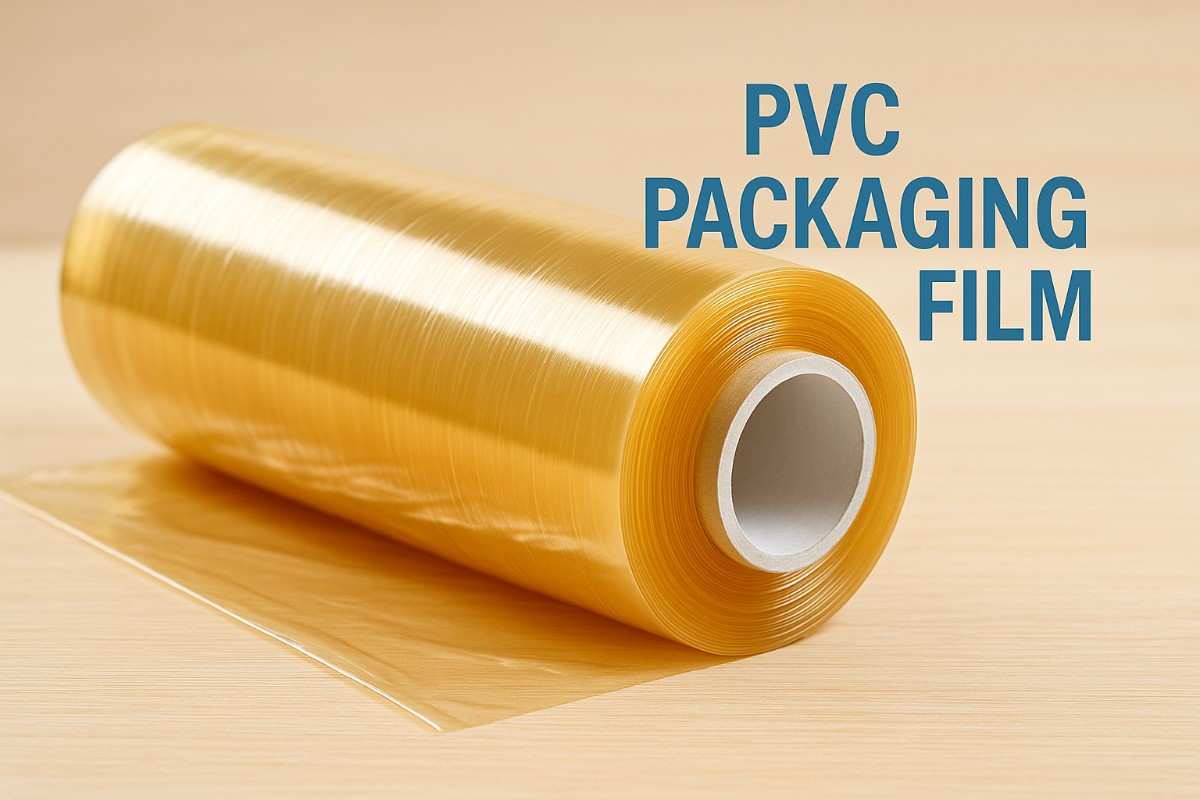The global polyvinyl chloride (PVC) packaging film market is projected to grow steadily over the next decade, expanding from USD 13.73 billion in 2024 to USD 17.48 billion by 2034. This reflects a Compound Annual Growth Rate (CAGR) of 2.43% between 2025 and 2034. The market value for 2025 is estimated at USD 14.06 billion, signifying consistent demand and industry confidence.

Regional Performance
-
Asia Pacific currently leads the global PVC packaging film market due to its strong manufacturing base, growing food sector, and cost-effective production.
-
North America is poised to experience the fastest growth in the coming years, supported by innovations in smart packaging and regulatory shifts that encourage sustainability.
Invest in Our Premium Strategic Solution: https://www.towardspackaging.com/download-databook/5647
Key Market Segments
By Layer Type
-
Multilayer films dominate the market thanks to their enhanced strength, barrier properties, and adaptability for diverse applications.
-
Single-layer films, however, are expected to grow at a notable CAGR through 2034, driven by advancements in mono-material solutions that support recyclability.
By Packaging Type
-
Flexible packaging leads the market due to its versatility, cost-effectiveness, and lower environmental impact compared to rigid packaging.
By Application
-
Food & Beverage remains the largest application segment in 2025, benefiting from PVC’s protective characteristics against oxygen, moisture, and contamination.
-
Pharmaceutical and Healthcare applications will witness strong growth due to PVC’s critical role in packaging for blister packs, IV bags, and medical tubing.
Get All the Details in Our Solutions – Access Report Preview: https://www.towardspackaging.com/download-sample/5647
Emerging Trends in PVC Packaging
1. Transition to Fully Recyclable Packaging
Global efforts are focused on designing recyclable PVC packaging that aligns with circular economy goals. Initiatives like the U.S. Plastic Pact and collaborations under the Alliance to End Plastic Waste are reshaping the packaging landscape, promoting materials that fit well into current recycling systems.
2. Emphasis on Environmental Impact Assessment
Brands are now utilizing Life Cycle Analysis (LCA) to evaluate packaging materials across their entire lifespan, including water use, carbon emissions, energy consumption, and waste. This enables smarter decisions for packaging design and material use.
3. Lightweighting and Waste Reduction
The industry is increasingly adopting “lightweighting” strategies—reducing material usage per unit without compromising performance. This not only decreases raw material costs but also supports lower shipping emissions and improved sustainability.
4. Growing Use of Post-Consumer Recycled (PCR) Content
Manufacturers are integrating PCR materials into packaging, reducing dependency on virgin plastic and responding to consumer demand for more sustainable options. This shift also aligns with environmental regulations and green product certifications.
5. Technological Innovations in Production
The industry is witnessing progress in:
-
Advanced Injection Molding for improved product consistency
-
PVC Surface Treatment to enhance weather resistance and durability
-
Thermoplastic Recycling Technologies enabling reuse of PVC without compromising quality
Opportunity: Green Innovation in PVC Production
The future of PVC lies in sustainable production, powered by renewable energy sources and high-efficiency manufacturing systems. PVC is now being used in renewable energy applications like wind turbines and solar panels and is instrumental in energy-saving construction materials.
Restraint: Environmental Challenges of Single-use Plastics
Despite these advancements, one major concern remains: single-use plastic packaging. A large portion of PVC packaging is still used once and discarded, often ending up in landfills or oceans. The longevity of plastic in the environment and the release of microplastics are ongoing environmental threats that the industry must continue to address.
Sector Insights
Food and Beverage
PVC is widely used to preserve food freshness and safety. It acts as a strong barrier against external factors and plays a major role in reducing food waste. Packaging solutions often include moisture barriers and heat seals that meet FDA compliance standards.
Pharmaceuticals
PVC’s flexibility, chemical resistance, and transparency make it ideal for pharma applications. Blister packs, IV bags, and drug tubing rely heavily on PVC films for secure, contamination-free storage.
General Packaging
PVC, along with materials like polycarbonate and acrylic, is widely used in product packaging across industries such as electronics, garments, toys, and cosmetics. Its clarity and durability make it a staple material for protective and display packaging.
Healthcare
For over five decades, PVC has been critical in healthcare, used in tubing, fluid containers, and blister packaging. Its hygienic and durable nature helps ensure safe patient care and long-term medicine storage.
If you have any questions, please feel free to contact us at sales@towardspackaging.com
Regional Analysis
Asia Pacific
The region remains dominant due to:
-
Rising industrial activity
-
Strong demand from food and pharma sectors
-
Recovery in PVC pricing and volume movement
-
Stable production and falling calcium carbide prices supporting margins
North America
The North American market is transforming through:
-
Adoption of sustainable and recyclable packaging
-
Smart packaging integration (e.g., freshness indicators, QR codes)
-
Regulatory initiatives like plastic registries and EPR programs
Recent Market Developments
-
AE Global received plastic-negative and plastic-neutral certifications through collaboration with rePurpose Global (May 2025)
-
LyondellBasell launched Pro-Fax EP649U, a new polypropylene impact copolymer for rigid packaging (March 2025)
-
ALPLA and SEA ME GmbH partnered to launch standardized PET bottles for cosmetic brands (August 2024)
-
INEOS Olefins and Polymers in France began using recycled plastic feedstock (June 2025)
Frequently Asked Questions (FAQs)
1. What is driving the growth of the global PVC packaging film market?
The market is driven by increasing demand from the food & beverage and pharmaceutical industries, growing environmental awareness prompting innovations in recyclable packaging, and steady demand from Asia Pacific markets.
2. Why is Asia Pacific the leading region in the PVC packaging film market?
Asia Pacific benefits from cost-effective production, high manufacturing activity, and rising demand for packaged food and pharma products. Recovery in PVC prices and production efficiencies also contribute to its leadership.
3. What sustainable trends are shaping the future of PVC packaging?
Key trends include the shift to fully recyclable materials, increased use of post-consumer recycled content, lightweighting strategies, and greener manufacturing powered by renewable energy.
4. What is the biggest environmental concern with PVC packaging?
The non-biodegradable nature of single-use PVC packaging and its contribution to long-term landfill waste and ocean pollution are major concerns, prompting calls for better recycling and eco-friendly alternatives.
5. Which industries are expected to show the strongest future growth in PVC packaging use?
The pharmaceutical and healthcare sectors are expected to experience significant CAGR due to the critical role of PVC in protective medical and drug packaging.
Source : https://www.towardspackaging.com/insights/polyvinyl-chloride-packaging-film-market-sizing

